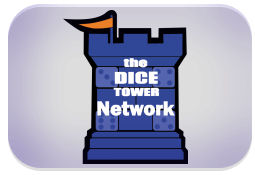Quick Board Game Reviews That Pack a Punch. No Rules, Just Opinions.
From the Publisher:
Welcome to the most well-known geisha street in the old capital, Hanamikoji. Geisha — the graceful women elegantly mastering in art, music, dance, and a variety of artistic performances after years of training — are greatly respected and adored. Geisha may be translated to “artist” and they dance, sing and entertain everyone.
In Hanamikoji, two players compete to earn the favors of the seven geisha masters by collecting the performance items with which they excel. With careful speculation and sometimes a few bold moves, you may earn the essential items by giving away the less critical ones. Can you outsmart your opponent and win the most favors of the geisha?

 There are four actions you make every round based on 21 cards of unequal sets of numbers in each suit, and they are simple and challenging. Two of the actions are hidden from your opponent and the other two require you to get them to not take the cards that you want. Many times I have put out card choices that seemed like an obvious choice and thought it inconceivable as to why they wouldn’t take them. In Hanamikoji, sometimes you get to be the Dread Pirate Roberts and sometimes you end up like Vizzini. There are four actions you make every round based on 21 cards of unequal sets of numbers in each suit, and they are simple and challenging. Two of the actions are hidden from your opponent and the other two require you to get them to not take the cards that you want. Many times I have put out card choices that seemed like an obvious choice and thought it inconceivable as to why they wouldn’t take them. In Hanamikoji, sometimes you get to be the Dread Pirate Roberts and sometimes you end up like Vizzini.
|
 Don’t let these lovely ladies fool you. Hanamikoji seems like a simple affair but is quite demanding. Reading your opponent and knowing when to sacrifice influence is key, but starting your turn with a card draw means you have to stay a little flexible with your tactics. Beginning players may feel lost, but experienced players will usually know they’ve made a mistake pretty quickly. It’s reminiscent of 2-player Knizia games like Lost Cities and Battle Line. Since a game rarely lasts more than 15 minutes or two rounds, you’ll be ready to go again, win or lose. Don’t let these lovely ladies fool you. Hanamikoji seems like a simple affair but is quite demanding. Reading your opponent and knowing when to sacrifice influence is key, but starting your turn with a card draw means you have to stay a little flexible with your tactics. Beginning players may feel lost, but experienced players will usually know they’ve made a mistake pretty quickly. It’s reminiscent of 2-player Knizia games like Lost Cities and Battle Line. Since a game rarely lasts more than 15 minutes or two rounds, you’ll be ready to go again, win or lose. |

 Half the decisions are dependent on the “I pick, you choose” mechanic, and it is quickly becoming a favorite. I love trying to figure out what my opponent is going to do, or if I can I offer them a deal that is too good to be true. The other two actions require you to secret away cards, and for a third layer there is one card that never gets used. The hidden knowledge adds just enough mystery to keep you guessing. Even the win condition of being able to influence the majority of Geisha or gain 11 influence points gives both players pause on which victory you are trying to accomplish. Half the decisions are dependent on the “I pick, you choose” mechanic, and it is quickly becoming a favorite. I love trying to figure out what my opponent is going to do, or if I can I offer them a deal that is too good to be true. The other two actions require you to secret away cards, and for a third layer there is one card that never gets used. The hidden knowledge adds just enough mystery to keep you guessing. Even the win condition of being able to influence the majority of Geisha or gain 11 influence points gives both players pause on which victory you are trying to accomplish.
|
 Mechanically, it’s quite simple. You have four actions in a round, and they’re all straightforward. Where things get hairy is trying to figure out what your opponent is holding, and drawing a new card each turn. This card can sometimes be a blessing or a curse, depending on which actions you’ve taken up to that point. If it’s one you need and you haven’t used your “Reserve” action, then you’re a lucky duck, but if it’s one your opponent needs and you have to make the three-card offer, then you might be stuck. Though luck does play a part, savvy players will know when to take their actions to avoid being put in the corner. Mechanically, it’s quite simple. You have four actions in a round, and they’re all straightforward. Where things get hairy is trying to figure out what your opponent is holding, and drawing a new card each turn. This card can sometimes be a blessing or a curse, depending on which actions you’ve taken up to that point. If it’s one you need and you haven’t used your “Reserve” action, then you’re a lucky duck, but if it’s one your opponent needs and you have to make the three-card offer, then you might be stuck. Though luck does play a part, savvy players will know when to take their actions to avoid being put in the corner. |

 Geisha are an embodiment of social grace and are peerless in their ability to entertain through conversation, music and dance. In this game you are trying to influence the Geisha by bringing them the objects with which they love to perform. Is the theme central to this game? Probably not. But I love Japanese themed games, and hearkening back to feudal Japan brings me joy. Geisha are an embodiment of social grace and are peerless in their ability to entertain through conversation, music and dance. In this game you are trying to influence the Geisha by bringing them the objects with which they love to perform. Is the theme central to this game? Probably not. But I love Japanese themed games, and hearkening back to feudal Japan brings me joy. |
 So many ‘colors and numbers’ games can be awful affairs, but the theme of winning influence with different geishas is fresh and fun. Gameplay can be tense at times, but never so much that this gentle theme feels inappropriate. It’s hardly essential but the theme fits well and adds a nice flavor to the proceedings, one you don’t find in many other games. So many ‘colors and numbers’ games can be awful affairs, but the theme of winning influence with different geishas is fresh and fun. Gameplay can be tense at times, but never so much that this gentle theme feels inappropriate. It’s hardly essential but the theme fits well and adds a nice flavor to the proceedings, one you don’t find in many other games.
|

 The art is one of the shining parts of this game, so let’s talk about the artist Maisherly for a moment. She is a Taiwanese artist that hasn't done a whole lot yet. I did find an interview from AnalogGames.com here if you want to learn a little more about her. She also is doing a series where she reimagines some of her favorite games. Go here to check them out. There is a strong element of Pop Surrealism mixed with an anime feel, and I think it’s quite wonderful. I can’t wait to see more from her. The art is one of the shining parts of this game, so let’s talk about the artist Maisherly for a moment. She is a Taiwanese artist that hasn't done a whole lot yet. I did find an interview from AnalogGames.com here if you want to learn a little more about her. She also is doing a series where she reimagines some of her favorite games. Go here to check them out. There is a strong element of Pop Surrealism mixed with an anime feel, and I think it’s quite wonderful. I can’t wait to see more from her. |
 Hanamikoji looks lovely on the table. The geishas are represented in a classical style with a modern twist and a pleasing palette of pastels. Each geisha is tastefully clothed compared to some other recent games, which is appreciated. It’s never failed to draw curious eyes and positive remarks when I’ve had it out. You’ll definitely want to sleeve this one. Hanamikoji looks lovely on the table. The geishas are represented in a classical style with a modern twist and a pleasing palette of pastels. Each geisha is tastefully clothed compared to some other recent games, which is appreciated. It’s never failed to draw curious eyes and positive remarks when I’ve had it out. You’ll definitely want to sleeve this one.
|

 The suggested price for this is $16.99, and that seems about right. There isn’t much in the box, which consists of 21 cards, 7 tarot sized cards, 15 tokens, and some amazing art. For such a small game, Hanamikoji offers bluffing, set collection/majority, simple card counting, hand management, and a whole bunch of tough fun decisions. The suggested price for this is $16.99, and that seems about right. There isn’t much in the box, which consists of 21 cards, 7 tarot sized cards, 15 tokens, and some amazing art. For such a small game, Hanamikoji offers bluffing, set collection/majority, simple card counting, hand management, and a whole bunch of tough fun decisions. |
 Blessed with a small box card game price, Hanamikoji takes a few simple components and turns them into a heaping helping of thoughtful, strategic gameplay. The depth of play is so satisfying that whenever you and a companion have some time to kill, this will be one of the first games you reach for. Blessed with a small box card game price, Hanamikoji takes a few simple components and turns them into a heaping helping of thoughtful, strategic gameplay. The depth of play is so satisfying that whenever you and a companion have some time to kill, this will be one of the first games you reach for.
|

 Many two player games have a very tit for tat feeling, but there is something very subtle about the game play in Hanamikoji. Every decision comes with a consequence that unknowingly can help or hurt which is very much like a Reiner Knizia design. Hanamikoji is basically a 2 player filler, and usually I take it easier on fillers, but not in this case. I give it a unqualified 6 on the Ducal scale. Many two player games have a very tit for tat feeling, but there is something very subtle about the game play in Hanamikoji. Every decision comes with a consequence that unknowingly can help or hurt which is very much like a Reiner Knizia design. Hanamikoji is basically a 2 player filler, and usually I take it easier on fillers, but not in this case. I give it a unqualified 6 on the Ducal scale. |
 It’s quick, simple to teach, strategically satisfying, and perfectly portable. There’s a nice amount of depth here with just a few components. Hanamikoji has a tantalizing amount of brain burn for experienced gamers, but is accessible enough for newer folks. It fits the role of filler but you won’t wear it out playing several games in a row. What’s not to love? It’s a solid 5 for me. It’s quick, simple to teach, strategically satisfying, and perfectly portable. There’s a nice amount of depth here with just a few components. Hanamikoji has a tantalizing amount of brain burn for experienced gamers, but is accessible enough for newer folks. It fits the role of filler but you won’t wear it out playing several games in a row. What’s not to love? It’s a solid 5 for me. |
| The Dukes of Dice Rating System |
|---|
| 1 = Poorly designed but playable. Not necessarily fun. |
| 2 = Game has some merit but has significant detractions. |
| 3 = Game is okay, not exciting. Will play in the right situation. |
| 4 = A good game. Worth playing, just not all the time. Belongs in the Duchy. |
| 5 = A great game, will rarely turn down a play of it. |
| 6 = An all-time favorite that is a contender for the top 10 |
If you want to connect with us you can find:
Matthew on Twitter as @uncouthtooth or matthew@dukesofdice.com
Matt on Twitter as @matosowalker
Join the discussion in our Board Game Geek Guild on this review HERE










1 ping
HeavyCon Recap with Matthew Ward | Board Game Gumbo
June 27, 2017 at 2:03 am (UTC 0) Link to this comment
[…] cards from their hand and others hide the information. Without going into full detail, you can see a full review here. It’s so much harder than it […]